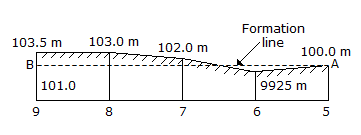Civil Engineering :: Estimating and Costing
- If tensile stress of a steel rod of diameter ‘D’ is 1400 kg/cm² and bond stress is 6 kg/cm², the required bond length of the rod is
- The most reliable estimate is
- The main factor to be considered while preparing a detailed estimate, is
- The order of booking dimensions is
-
The reduced levels of points, 30 metres apart along the longitudinal section of a road portion between chainages 5 and 9 are shown in the given figure. If there is a uniform up-gradient of the road 120 in 1, the chainage of the point with no filling or cutting is

- The expected out turn of brick work in cement mortar in foundation and plinth per mason per day, is
- Pick up the correct statement regarding the centre line method of estimating a building
- For 12 mm thick cement plastering 1 : 6 on 100 sq.m new brick work, the quantity of cement required, is
- For 100 sq. m cement concrete (1 : 2: 4) 4 cm thick floor, the quantity of cement required, is
- The measurement is not made in square meters in case of
|
A.
Product of the centre line of the walls and area of cross-section of any item, gives total quantity of the item |
|
B.
The centre line is worked out separately for different sections of walls of a building |
|
C.
The centre line length is reduced by half the layer of main wall joining the partition wall |
|
D.
All the above |


 Whatsapp
Whatsapp
 Facebook
Facebook

